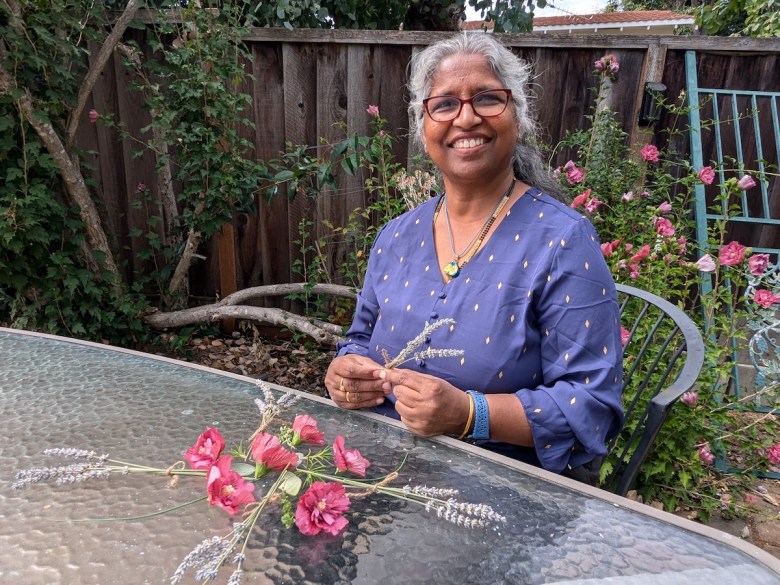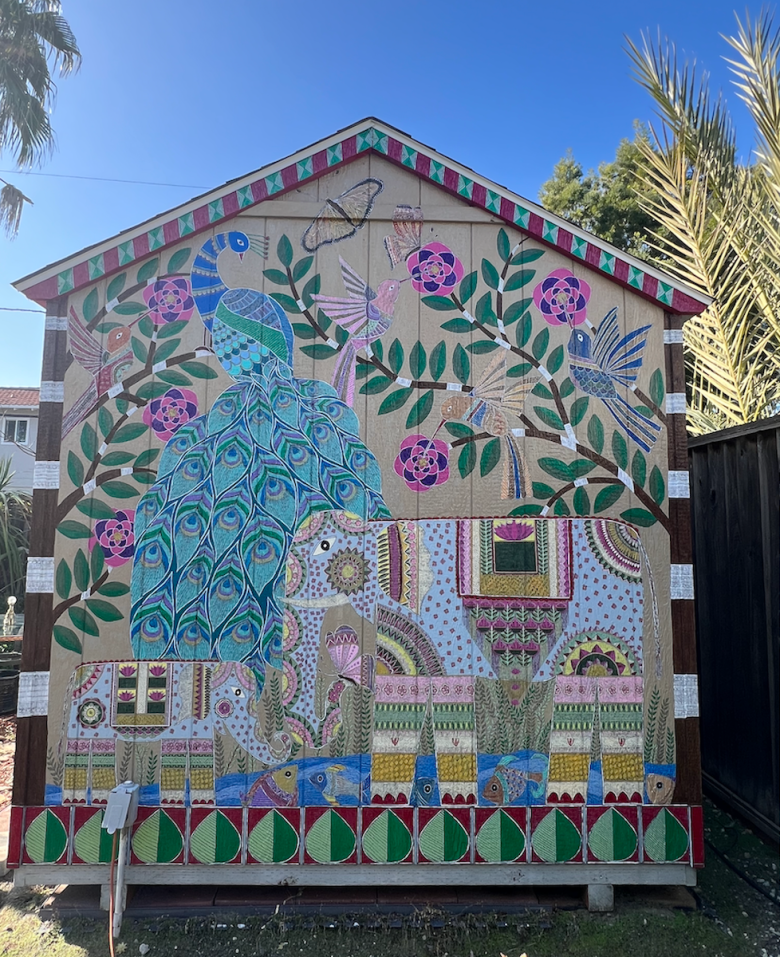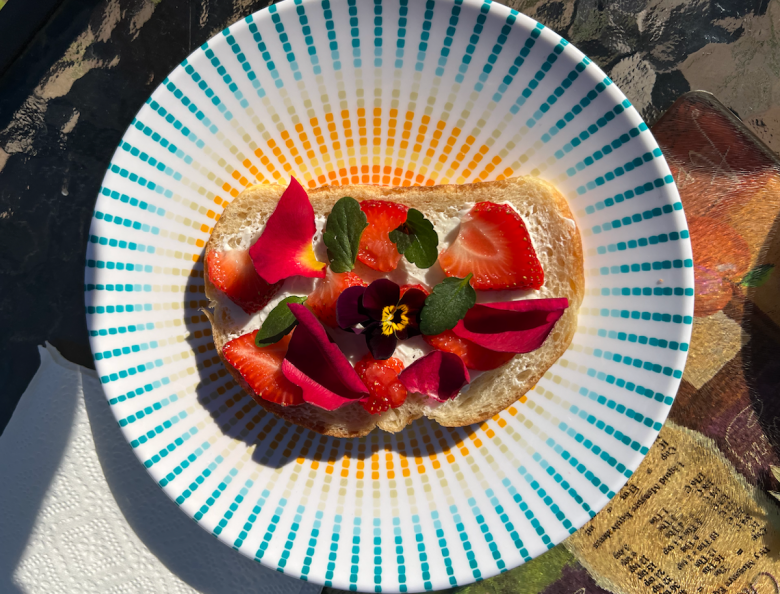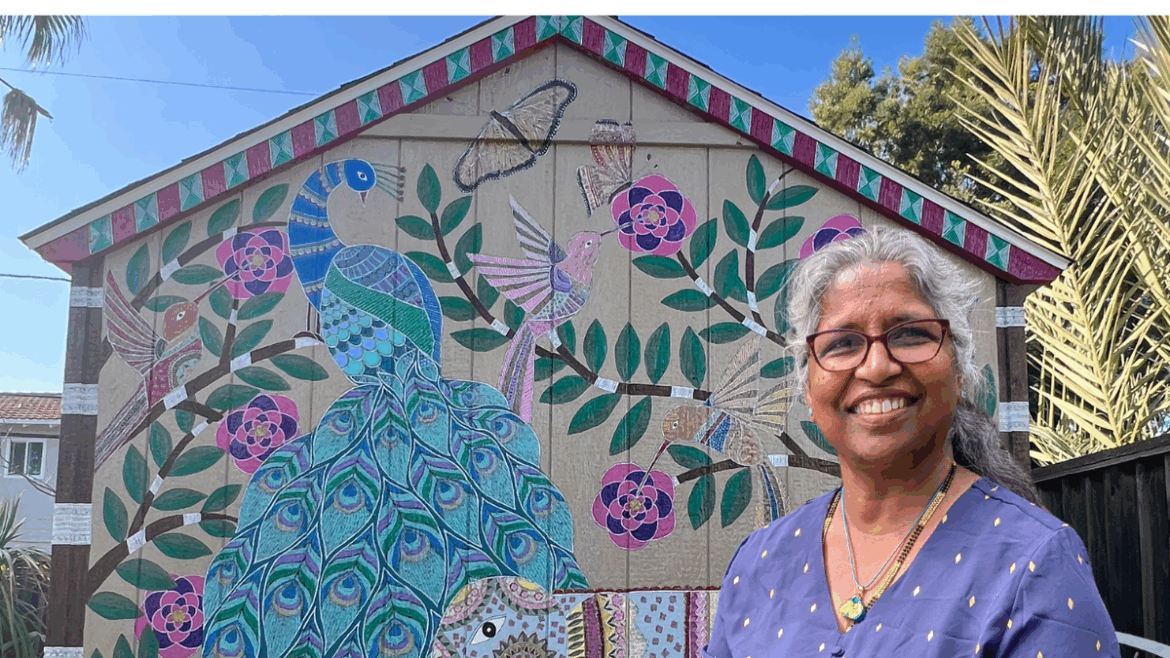Estimated reading time: 9 minutes
The Art of Horticultural Therapy
Gardening isn’t just good for your body—it’s great for your mind too, says horticultural therapist Rohini Deshpande. The process itself is therapy.
“The whole thing about growing something — It’s tending to it. You plant it. You’re watering it. You’re making sure it’s getting enough sun. You’re making sure it’s getting enough water. You’re making sure it has enough space to grow. You’re making sure the medium in which you’re growing is enriching enough for it to survive.”
 Rohini Deshpande in her garden (image courtesy: Rohini Deshpande)
Rohini Deshpande in her garden (image courtesy: Rohini Deshpande)
We are problem-solving the entire time, says Deshpande. “While that journey is also cognitive, we are very much present when we are tending to the plant.”
While developing gardening workshops for adults with intellectual disabilities, Deshpande noticed the activities did much more than just fill time—they improved fine motor skills, encouraged social connection, stimulated the senses, and supported both cognitive and mental health.
Everything is hands-on — it’s not passive, it is active.
Seeds of Healing
Growing up in India, Deshpande developed a love for plants at an early age. She spent much of her childhood vacations on her family’s land in Maharashtra, where her father nurtured her budding interest in nature and farming. “My dad would always be fascinated about growing this, growing that, and always used to encourage me with plants…. I would collect leaves and make a journal out of it.”
While many of her peers leaned toward careers in medicine or engineering, she chose a different path—studying agriculture in Pune and eventually earning a master’s degree in horticulture. As Deshpande explains, horticulture is a branch of agriculture that focuses specifically on fruits, vegetables, and ornamental plants.
Her journey continued to a PhD in the field from Nebraska.
 Rohini Deshpande’s handpainted garden shed (image credit: Anjana Nagarajan-Butaney)
Rohini Deshpande’s handpainted garden shed (image credit: Anjana Nagarajan-Butaney)
While raising her children, she continued to nurture her artistic side through painting and sculpture, all while keeping her passion for gardening alive at her home in the Bay Area. She began teaching art classes to children, both in person and online, while also getting involved with Returnize—a program that supports women returning to the workforce. With encouragement from Swati Vora at Returnize, she decided to pursue her long-standing interest in horticulture, eventually earning a certification in horticultural therapy from Colorado State University.
Cultivating Calm
As part of her certification, Deshpande completed a 480-hour internship, which led her to work at two centers in Redwood City.
One served adults of various ages with different needs. She visited the center twice a week and led additional gardening activities on other days. Working with groups of 10 to 12 participants, she tailored sessions based on each group’s abilities.
One example that stands out to Deshpande was a man who usually didn’t talk or smile and seemed very serious. But after he started coming to her sessions, he began to open up. They found out he could write full sentences well, and he even started smiling.
“He would be all smiles every time I went there. He would be all smiles, ready to work in the garden, and after the session, he would describe with so much excitement that this is what he did today to the staff, or to whoever was over there.” The supervisors were surprised that gardening brought that joy to him.
 Rohini Deshpande in her garden (image courtesy: Anjana Nagarajan-Butaney)
Rohini Deshpande in her garden (image courtesy: Anjana Nagarajan-Butaney)
The Healing Power of Plants
The other facility that Deshpande worked in was a memory care center that had a unique and thoughtful model. They had incorporated a garden space within the unit, featuring small, raised beds that were easily accessible for the residents.
She visited 1-2 times a month, and the residents sometimes didn’t remember her. That was always a challenge. Each visit often felt like meeting them for the first time—she would reintroduce herself, and they would start fresh every time.
“It’s the sensory parts that stimulated them, like if I gave them some herbs or something to smell. Then they would suddenly remember — Oh, I used to cook with this. ….. They would go back to their childhood and say; Oh, I used to do this with my dad.” The gardening used to unlock some memories, and they would talk about it.
Because they don’t have their homes anymore and live in a senior living facility, they would reminisce with Deshpande, “I used to have a garden, and I used to have this plant.” It’s harder for people who have lost their sense of smell because the sense for aroma is missing. But there are several sensory aspects, and they can still see, touch and feel the plant.
The group sessions incorporated seasonal produce like herbs, flowers, tomatoes, and strawberries. While the participants enjoyed the process, the sessions ended with a group meal made with the produce they harvested.
 Garden to Table, flower-inspired snacks (image credit: Anjana Nagarajan-Butaney)
Garden to Table, flower-inspired snacks (image credit: Anjana Nagarajan-Butaney)
“There are some recipes in which we grew peas, and they had never seen a fresh pea in their life, or even tasted one. Only frozen,” describes Deshpande.
“So, we grew peas, and they actually saw the plant. They saw the pods, and these ones were where you can also eat the shells. So we harvested it. I said you can see the peas inside, and you can also eat the shell of the pod. And they just ate — just the fresh peas like that. And they were very fascinated by that whole process because they grew it.”
Peas are generally easy to grow, explains Deshpande, because they grow quickly—you can sow the seeds and start seeing pods within two months.
Gardens That Heal
In horticultural therapy, everything is hands-on—you’re not just sitting and talking. You’re actively doing something, and that kind of involvement helps. Deshpande finds that people often open up more when their hands are busy, and the activity supports both physical and mental well-being.
Unlike traditional talk therapy, where someone sits in front of you and asks questions, Deshpande says that here you’re working with your hands—digging, planting, watering. That movement itself can be calming. For example, if someone feels agitated or overwhelmed, simply going into the garden and pulling weeds can be therapeutic. On the surface, it’s just a task. But symbolically, it can feel like removing negative thoughts or clearing mental clutter.
 A flower sandwich (image courtesy: Rohini Deshpande)
A flower sandwich (image courtesy: Rohini Deshpande)
Nature teaches us so many things, explains Deshpande. Even when something we plant doesn’t survive, that’s part of the process—and part of life. There’s always something to learn from it.
“And we can maybe have a grief situation where we lose someone, and the same thing with plants. We grow it, and it may not survive. We put all our love into it, water, and everything. You did all the right things, and it didn’t survive. But that is life again. Or some plants only have this much of life. It’s an annual. It grows for one season, and it’s gone. That’s also a lesson. So all these we learn.”
Grow, cook, and heal together!
Through her work, Deshpande was inspired to put together a recipe book, “Garden to Table: Simple Recipes with Herbs & Edible Flowers,” based on the various projects she carried out at the facilities, combining her passion for food, art, gardening, and community.
As Deshpande describes it “This is more than just a recipe book—it’s a mindful guide to reconnecting with nature, enhancing well-being, and exploring the benefits of herbs and edible flowers. Rooted in the principles of horticultural therapy, each recipe is designed to reduce stress, promote mindfulness, increase socialization, and gain physical skills.”
 A flower panckake (image courtesy:Rohini Deshpande)
A flower panckake (image courtesy:Rohini Deshpande)
This book follows a five-stage gardening journey, starting with planting seeds or seedlings and moving through nurturing, harvesting, drying, and finally transforming the harvest into simple, delicious recipes.
Deshpande published this book to promote socialization and joy through gardening activities. “I’m hoping that more and more people use this book, not only just in home settings, but as group sessions in hospitals and anywhere they have some culinary activities that they do.”
Food always brings joy, shares Deshpande, and as a society, “we are very nuclear, and this can help promote that feeling of togetherness. We’re doing something together, and it brings joy to everybody.”
A journey in nature
It’s very much a journey, explains Deshpande. It’s not about having a green thumb. It’s really about the experience of growing something, learning along the way, and being part of that process. Some plants are grown for food, like fruits and vegetables, while others are simply there to be appreciated for their beauty.
 Rohini and Anjana create a sandwich (image credit: Anjana Nagarajan-Butaney)
Rohini and Anjana create a sandwich (image credit: Anjana Nagarajan-Butaney)
While I spent a lovely morning in Deshpande’s garden discussing her journey and her book, we ended up practicing a bit of therapy ourselves—harvesting edible flowers and herbs to create a simple, healthy snack of hibiscus tea and a flower sandwich. It was a feast for both the eyes and the palate.
Along the way, I learned so much that I hope to carry it into my own garden. Maybe pulling a few weeds to find moments of calm, especially when writer’s block sets in.
Related


Comments are closed.